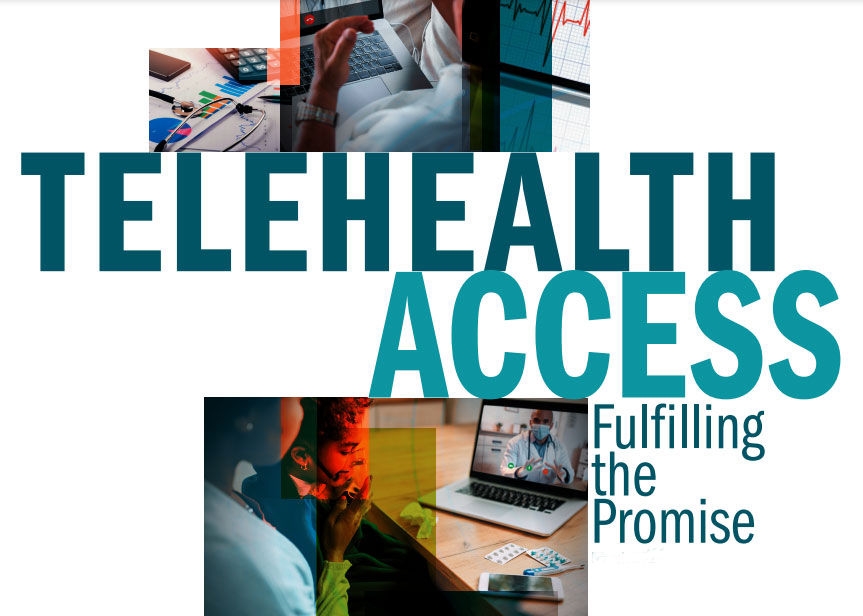How Telehealth Can Fulfill the Promise of Increased Access

URAC’s Telehealth White Paper includes discussion with leaders from Ain Shams Virtual Hospital, Children’s National Hospital, Mindpath Health, Onduo and StationMD. Each organization shares a story of how they are using telehealth to address access issues for the patients they serve.
There is a vital role that telehealth can play in expanding access to necessary health care services across the globe. URAC talked to health care leaders all over the world to ask their opinions on how their organizations utilize technology to advance health care for the patients they serve. Their stories show the reach and breadth of the types of patients that can be served safely and effectively with telehealth, including patients living in rural communities, those with mental health diagnoses, as well as elders living away from family members.
And that’s no surprise since we know that one of the promises of telehealth adoption was to expand access to medical services and care by bringing care to patients rather than the other way around. In fact, the first telehealth demonstration projects focused on increasing access to specialty care at rural hospitals and for other underserved populations.
But, due to a variety of logistical, technical and regulatory reasons, that promise went largely unfulfilled. Some of the most innovative and groundbreaking players in the telehealth arena recognized the potential of telehealth long before the pandemic: the promise of greater access, better continuity of care and improved outcomes, especially for hard-to-reach and underserved populations.
An opportunity arose, however, in March 2020, when the Centers for Medicare and Medicaid Services (CMS) relaxed long-standing rules and regulations due to the COVID-19 public health emergency. CMS opened the gates to a whole new way to deliver quality care to patients at home or closer to home. The pandemic forced health care delivery to become patient-centered in ways we’ve talked about for years but rarely delivered. A full waiting room works better for providers than for patients, who often must travel or miss work. Telehealth opens the possibility of meeting the patient where they live—literally—and addressing many hurdles to overall better health outcomes.
The explosive growth in telehealth has opened access to a wide spectrum of clinical and non-clinical health-related services. The pandemic gave a powerful tool to brilliant people and let them invent for a year. Because of this, health care delivery will never be the same. The sudden ramp-up gave the early adopters in the provider community a way to show the potential of the technology and forced those hesitant to give it a try. Now we are seeing champions who may have initially been resistant to it, who now have tried it and have liked it and have seen its benefit both for their patients and their own way of doing business.
Patients, too, have seen the promise. At the start of the pandemic, fewer than 20 percent of Americans reported having ever had a telehealth appointment and two-thirds felt hesitant about or doubted the quality of care provided remotely. A year later, in March 2021, the majority of Americans had seen a doctor via telehealth, and nearly 80 percent believed that they could receive quality care in this way. Nearly 90 percent said they wanted to continue to use telehealth for non-urgent consultations post-pandemic.
The pandemic moved virtual health care onto the express route to the future. Providers and innovators have responded by accelerating their telehealth efforts and expanding access to underserved populations – whether they be disadvantaged geographically or economically or challenged due to their diagnoses. While the pace of change seen in 2020 is unlikely to be matched in the future, both providers and patients remain keen to take advantage of the myriad benefits that telehealth services can offer. For now, telehealth has proven itself to be a valuable means of providing care to patients in the comfort of their homes – or anywhere with digital access. The bonus of convenient, safe and timely care demonstrates that while telehealth is still evolving, it’s surely here to stay.
 About the Author
About the Author
Dr. Shawn Griffin is the first physician to serve as President & CEO for URAC – the country’s leading independent, nonprofit accreditation organization. Shawn brings a fresh view and leading-edge ideas to the sometimes-rigid world of health care. He has expertise in a wide variety of health care topics and can be counted on for engaging and insightful commentary that’s relevant to health care professionals and approachable for laypeople.

